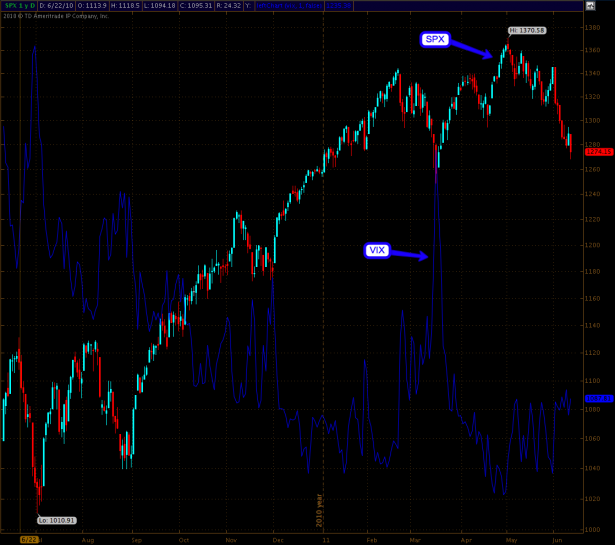Spiking The Punch
Spiking The Punch
I often write about the games those evil ‘maker makers’ are playing and some of you might not be aware that they actually serve an integral role in the financial markets. Taking right off the Wikipedia page:
A market maker is a company, or an individual, that quotes both a buy and a sell price in a financial instrument or commodity held in inventory, hoping to make a profit on the bid-offer spread, or turn. From a market microstructure theory standpoint, market makers are net sellers of an option to be adversely selected at a premium proportional to the trading range at which they are willing to provide liquidity.
So in plain English – those guys’ job is to take the other side of our trades, a.k.a. providing liquidity, which is as you can imagine is not for the faint of heart. This is maybe why much of this is being done by the bots today but it’s the base principle. Of course making markets is not an altruistic endeavor – we’re all in it for the money after all. So, you can’t blame those guys to use their skills and a certain measure of (ahem) creativity to try to stick it to us retail traders every now and then.

One of the tricks in the MM’s arsenal is what I refer to as ‘spiking the punch’ and I have a simple chart that will paint the picture for you:
[amprotect=nonmember]
Charts and commentary below for anyone donning a secret decoder ring. If you are interested in becoming a Gold member then don’t waste time and sign up here. And if you are a Zero subscriber it includes access to all Gold posts, so you actually get double the bang for your buck.
[/amprotect]
[amprotect=1,9,5,2]

What you are looking at here is a left chart of the VIX against the SPX – clear enough. Now let’s look at the two largest retracements in the past year. As you can see almost without fail every time the SPX dropped by more than three handles the VIX was spiking up like a Geiger counter near Fukushima Daiichi. And invariably we pushed outside the 2.0 BB and the obligatory short squeeze ensued. This is in part what that apparently puzzling VIX buy signal is based on and it has worked like clockwork for us during the past two years.
As you probably know now – this is a typical sucker play – the tape gets walked down, maybe you’ll see some panic selling and at some point we arrive at reasonable support line. Of course the plush teddies can’t help themselves – after ignoring all the early reversal they usually start accumulating positions way too late. ZH starts posting doomsday articles and everyone is chasing the tape to the downside. The VIX ramps up sky high and market makers sell expensive premiums to the bear piggies.
You know what happens next. There’s a reversal and the VIX drops like a rock, so hard that vega slices and dices all those put premiums into oblivion. The plush teddies panic and start buying back (or sell their puts at much lower premiums) – the tape ramps even higher and Rite Aid starts running out of vaseline jars. The guys left standing with a big smile on their faces? Yes, you guessed it – the market makers who happily sold you expensive premium at the very bottom. So, this is how the game is being played.
Until now.
If you compare the drop in March with the current one there’s something salient that stands out right away. That’s right, given how much we have already retraced isn’t it a bit surprising how little the VIX has moved? The current reading is 18.79 which is a few ticks away from yesterday’s close. So what’s going on here?
Several schools of thought. First let’s resort to statistics – yes, yes, it’s boring but it can be exciting if it helps you steal someone else’s lunch 😉

You may remember Volar’s VIX correlation chart which I asked him to produce. Now, recall that statistically this correlation appears to be lowest during the summer months. Now, that may be the case but I don’t think this is what accounts for what’s going on right now. Why? Because last June the SPX also dropped and the VIX ramped up like crazy.
Now the other explanation I can offer is that it’s possible that market forces are changing and that market makers are keeping the VIX low for a reason. What could that be? Well, maybe perhaps there’s a lot of upside exposure in equities among institutional traders right now and this happens to not be a sucker play. Of course a bounce will come eventually and it would offer a great opportunity to scale out of long positions and leave the retail traders holding the bag – some refer to this process as ‘distribution’.
The counter theory to all this of course is that rising vega lifts both puts and calls (i.e. options in general) – especially if you were holding OTM calls and didn’t experience a big drop in delta. If prices don’t move and VIX for some reasons ramps up you will see an increase in your call premiums.
Frankly, I cannot offer a conclusive theory here – the only thing I wanted to point out is that ‘something is different’ now. And for some reason the MMs didn’t spike the punch this time around. Which of course also sucks if you managed to catch the top and loaded up on puts. Perhaps that is the game this time around but we can’t be sure.
Cheers,
Mole
[/amprotect]











